This guide uses Supabase as the backend database provider for its seamless integration with PowerSync. However, you can integrate a different backend using custom actions. For more information, refer to the Custom backend connectors section.
Guide Overview
Before starting this guide, you’ll need:
- A PowerSync account (sign up here).
- A Supabase account (sign up here).
- A paid plan with FlutterFlow for the ability to import a Library into a project.
- Configure Supabase and PowerSync Prerequisites
- Initialize Your FlutterFlow Project
- Build a Sign-in Screen
- Read Data
- Create Data
- Update Data (Guide coming soon)
- Delete Data
- Sign Out
- (New) Display Connectivity and Sync Status
- Secure Your App
- Enable RLS in Supabase
- Update Sync Rules in PowerSync
Configure Supabase
- Create a new project in Supabase.
- To set up the Postgres database for our demo app, we will create a
liststable. The demo app will have access to this table even while offline. Run the below SQL statement in your Supabase SQL Editor: - PowerSync uses the Postgres Write Ahead Log (WAL) to replicate data changes in order to keep PowerSync SDK clients up to date. Run the below SQL statement in your Supabase SQL Editor to create a Postgres role/user with replication privileges:
To restrict read access to specific tables, explicitly list allowed tables for both the
SELECTprivilege, and for the publication mentioned in the next step (as well as for any other publications that may exist). - Create a Postgres publication using the SQL Editor. This will enable data to be replicated from Supabase so that your FlutterFlow app can download it.
Configure PowerSync
Create a PowerSync Cloud Instance
When creating a project in the PowerSync Dashboard, a Development and Production instance will be created by default. Select the instance you want to configure. If you need to create a new instance, follow the steps below.- In the dashboard, select your project and open the instance selection dropdown. Click Add Instance.

- Give your instance a name, such as “Production”.
- [Optional] You can change the default cloud region from US to EU, JP (Japan), AU (Australia) or BR (Brazil) if desired.
- Note: Additional cloud regions will be considered on request, especially for customers on our Enterprise plan. Please contact us if you need a different region.
- Click Create Instance.
Connect PowerSync to Your Supabase
-
From your Supabase Dashboard, select Connect in the top navigation bar (or follow this link):

-
In the Direct connection section, copy the complete connection string (including the
[YOUR-PASSWORD]placeholder)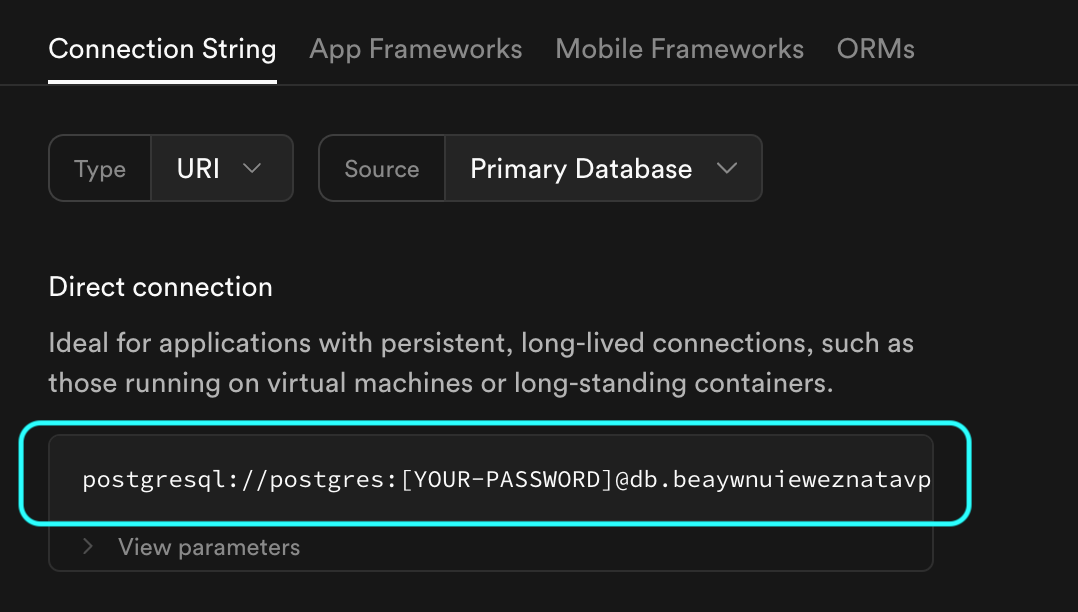
- In the PowerSync Dashboard, select your project and instance and go to the Database Connections view.
- Click Connect to Source Database and ensure the “Postgres” tab is selected.
- Paste the connection string into the URI field. PowerSync will automatically parse this URI to populate the database connection details.
-
Update the Username and Password fields to use the
powersync_roleand password you created when configuring your Supabase for PowerSync (see Source Database Setup). -
Note: PowerSync includes Supabase’s CA certificate by default, so you can use
verify-fullSSL mode without additional configuration.
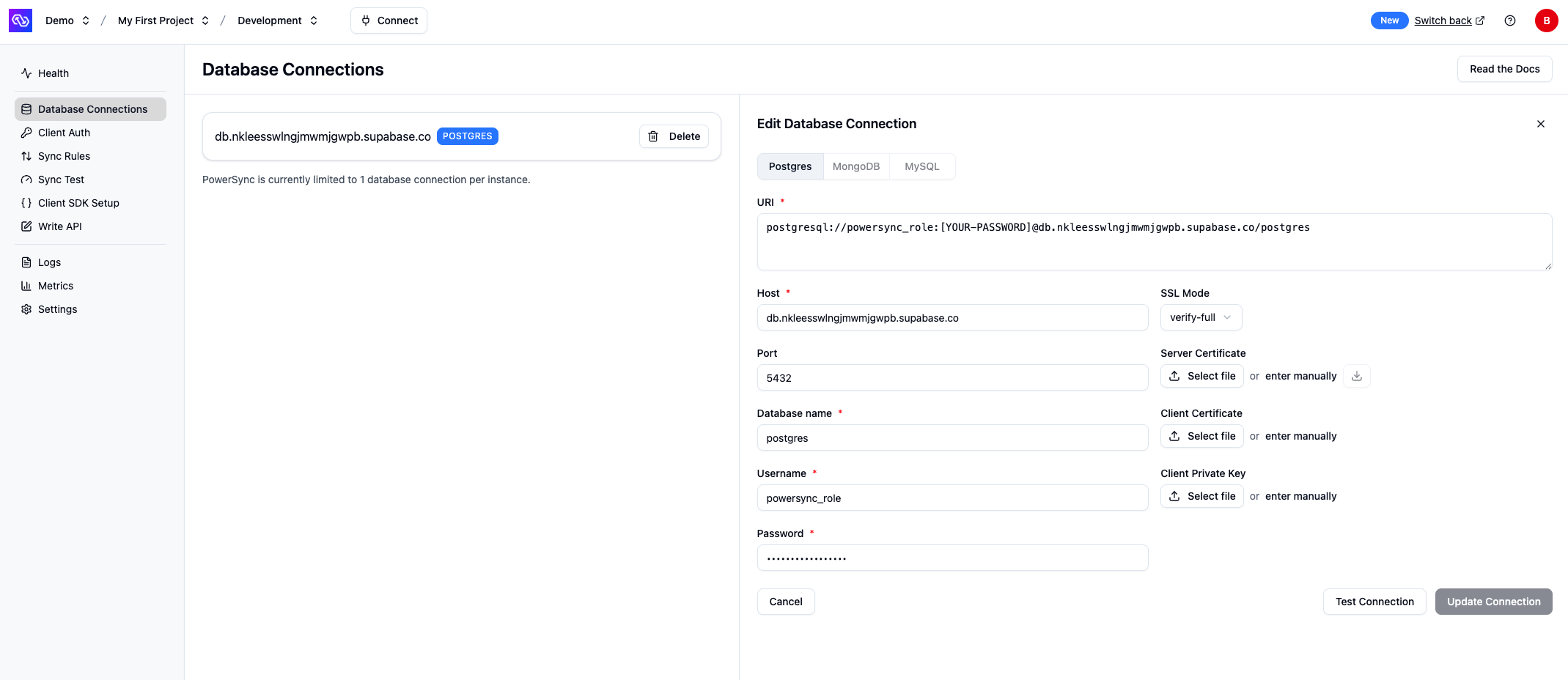
Your Supabase connection details should look similar to this.
- Verify your setup by clicking Test Connection and resolve any errors.
- Click Save Connection.
Enable Supabase Auth
After your database connection is configured, enable Supabase Auth:- In the PowerSync Dashboard, go to the Client Auth view.
- Enable the “Use Supabase Auth” checkbox.
- If your Supabase project uses the legacy JWT signing keys, copy your JWT Secret from your project’s settings (JWT Keys) and paste the secret into the “Supabase JWT Secret (optional) Legacy” field. If you’re using Supabase’s new JWT signing keys, you can leave this field empty.
- Click Save and Deploy to apply the changes.
PowerSync is compatible with Supabase’s new JWT signing keys. If you’re using the new keys, you don’t need to provide the legacy JWT secret. See this Discord thread for details.
Configure Sync Rules
Sync Rules allow developers to control which data gets synced to which user devices using a SQL-like syntax in a YAML file. For the demo app, we’re going to specify that each user can only see their own lists.- In the PowerSync Dashboard, select your project and instance and go to the Sync Rules view.
-
Edit the Sync Rules in the editor and replace the contents with the below:
- Click “Validate” and ensure there are no errors. This validates your Sync Rules against your Postgres database.
- Click “Deploy” to deploy your Sync Rules.
- Confirm in the dialog and wait a couple of minutes for the deployment to complete.
Initialize Your FlutterFlow Project
- Create a new Blank project in FlutterFlow.
- Under “App Settings” -> “Integrations”, enable “Supabase”.
- Enter your Supabase “API URL” and public “Anon Key”. You can find these under “Project Settings” -> “API Keys” ->
anonpublicin your Supabase dashboard. - Click “Get Schema”.
- Enter your Supabase “API URL” and public “Anon Key”. You can find these under “Project Settings” -> “API Keys” ->
- Add the PowerSync Library to your FlutterFlow account.
- Under “App Settings” -> “Project Dependencies” -> “FlutterFlow Libraries” click “Add Library”.
- Select the “PowerSync” library.
- Add your schema:
- In the PowerSync Dashboard, select your project and instance and click the Connect button in the top bar to generate the client-side schema based on your Sync Rules. Select “FlutterFlow” as the language.
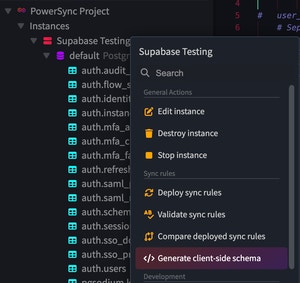
- Copy and paste the generated schema into the “PowerSyncSchema” field.
- Copy and paste your PowerSync instance URL into the “PowerSyncUrl” field.
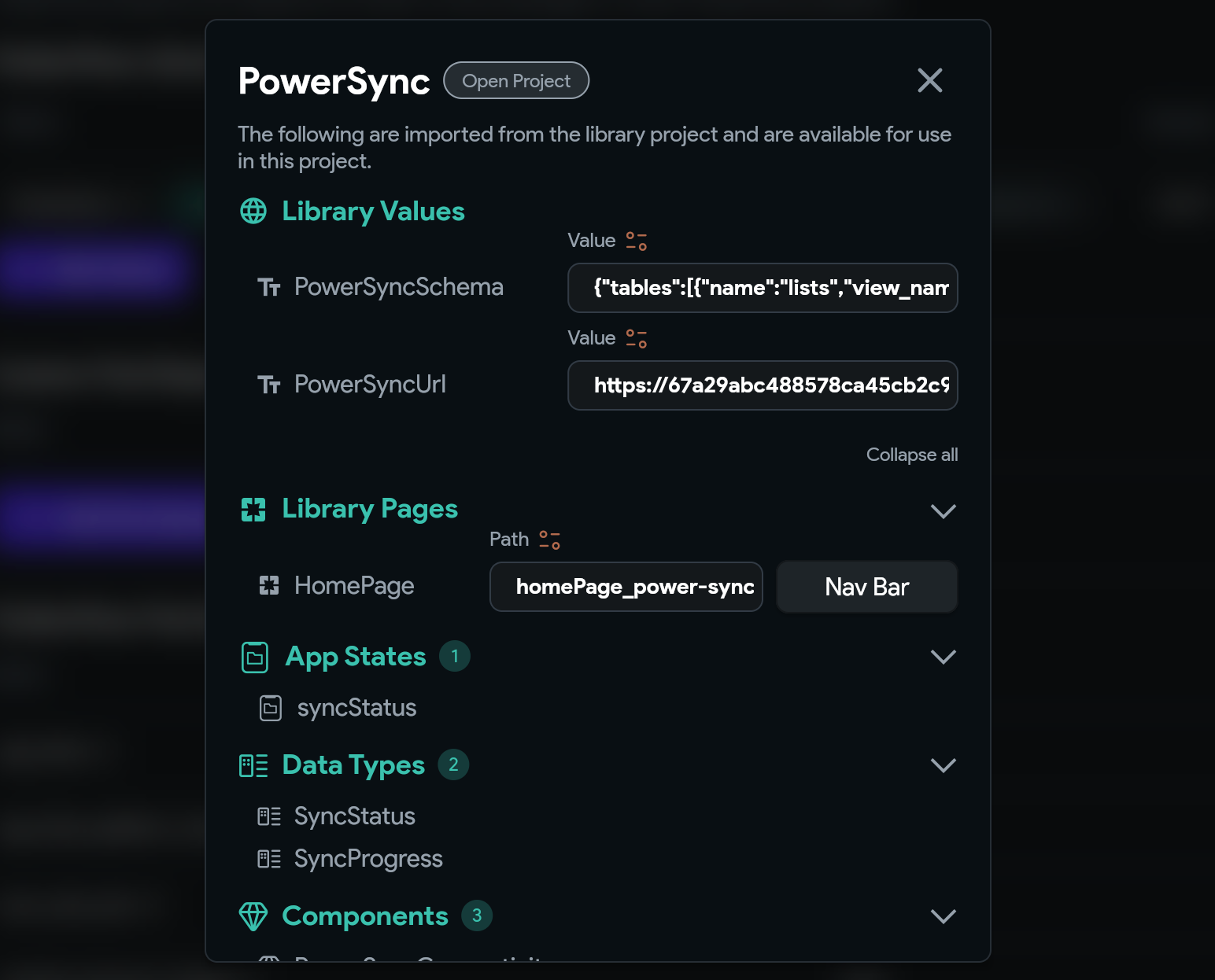
- Note: The default path for the “HomePage” field under “Library Pages” can be left as is and ignored. FlutterFlow does not currently provide a way to remove it.
- Close the library config.
- Under “Custom Pub Dependencies”, add a dependency on
powersync_core:1.3.0:
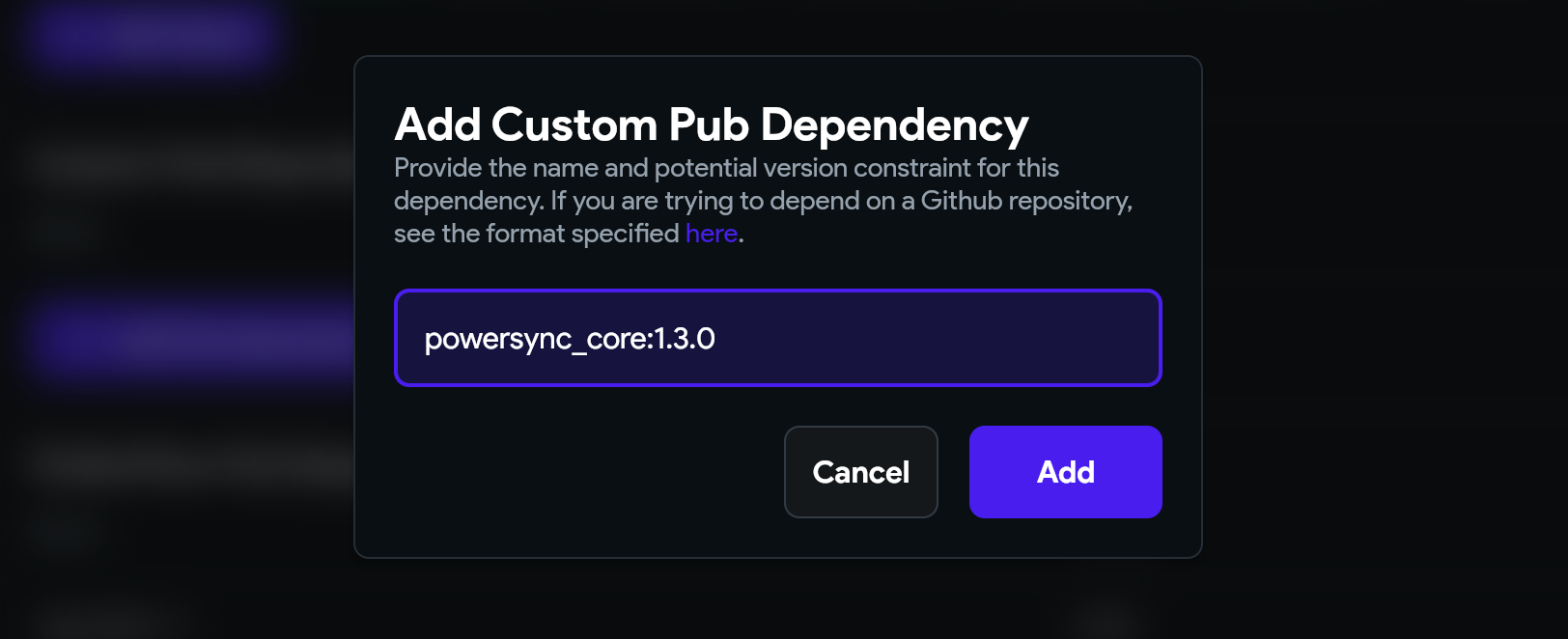
powersync_core is required for running FlutterFlow on Web.
Build A Sign-In Screen
- Under the “Page Selector”, click “Add Page, Component, or Flow”.
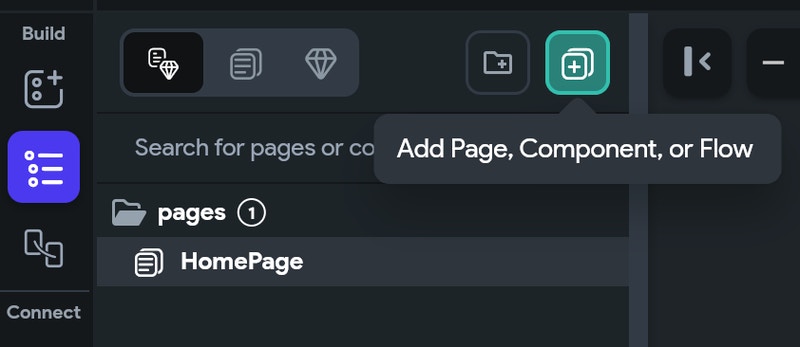
- Select the “Auth 1” template and name the page
Login. - Delete the Sign Up, Forgot Password and Social Login buttons — we will only be supporting Sign In for this demo app.
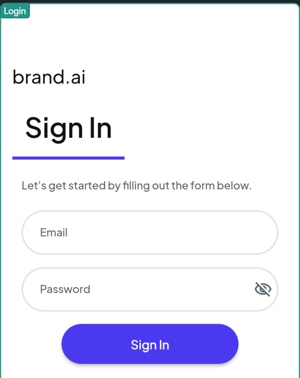
- Under “App Settings” -> “App Settings” -> “Authentication”:
- Enable Authentication.
- Set “Authentication Type” to “Supabase”.
- Set “Entry Page” to the
Loginpage you just created. - Set “Logged In Page” to “HomePage”.
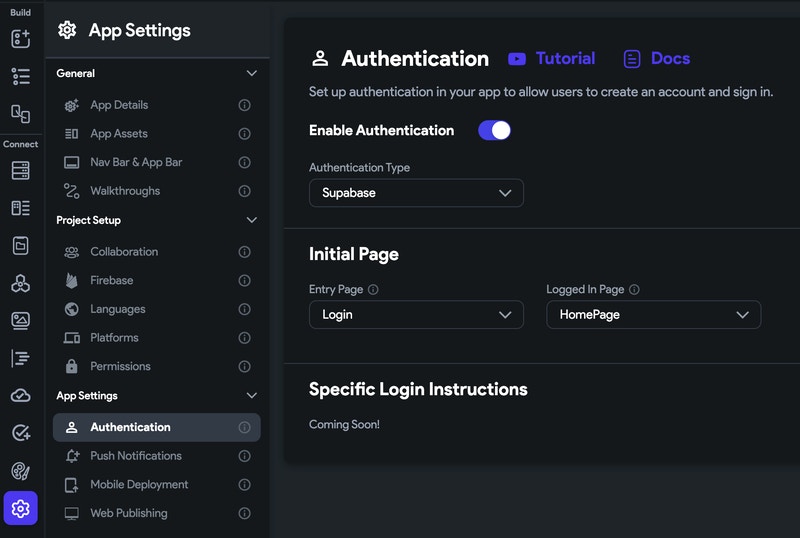
- In your Supabase Dashboard, under “Authentication”, click on “Add User” -> “Create new user” and create a user for yourself to test with:
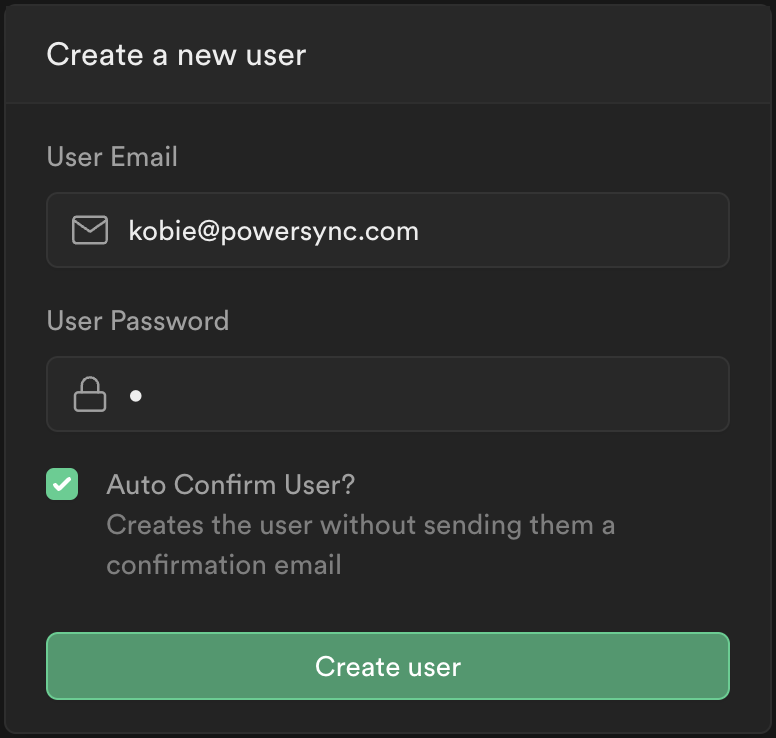
- Test your app with test mode:
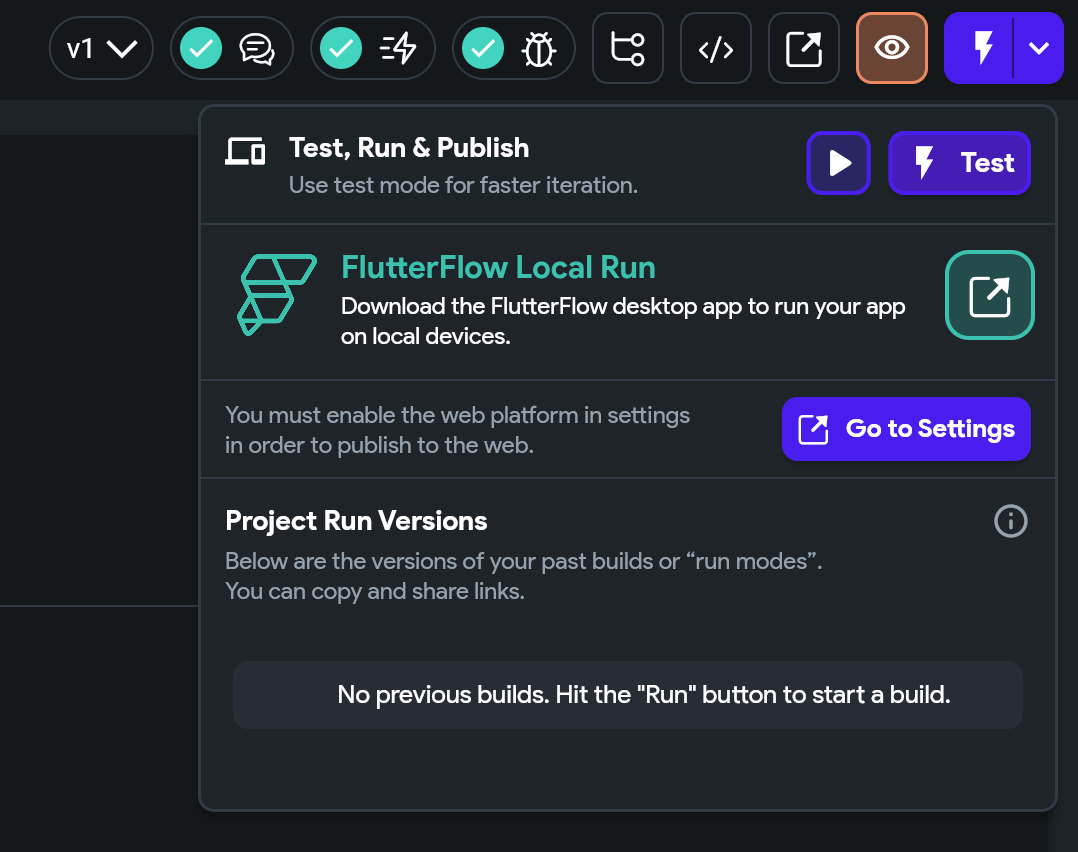
Click on 'Test'
Checkpoint: You should now be able to log into the app using the Supabase user account you just created. After logging in you should see a blank screen.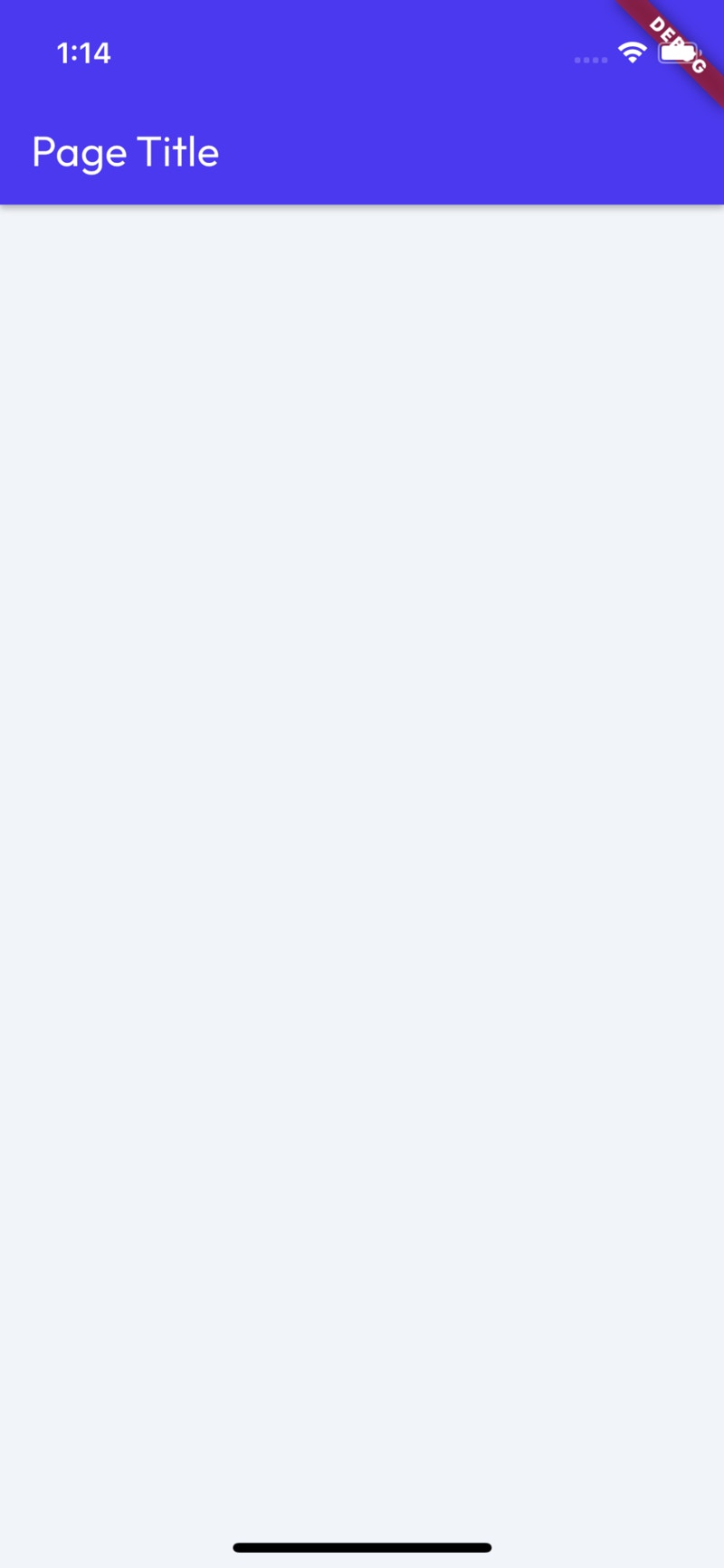

For once, a blank screen means success!
Read Data
We will now create our first UI and bind it to the data in the local SQLite database on the device. There are three ways to read data from the SQLite database using PowerSync’s FlutterFlow library:- Auto-updating queries for Layout Elements with Dynamic Children e.g. the ListView Element
- This uses the library’s
PowerSyncQuerycomponent.
- This uses the library’s
- Auto-updating queries for basic Layout Elements e.g. Text Elements.
- This uses the library’s
PowerSyncStateUpdatercomponent.
- This uses the library’s
- Once-off reads for static data.
- This uses the library’s
PowerSyncQueryOncecustom action.
- This uses the library’s
Prepare Supabase Tables for Reads
For reading data in FlutterFlow, you need a Custom Function per Supabase table to map Supabase rows to data that can be used by the library. This is because FlutterFlow Libraries do not support Supabase classes.- Navigate to “Custom Code” and add a Custom Function.
- Name the function
supabaseRowsToList(if your Supabase table name is “Customers”, you would name thissupabaseRowsToCustomers). - Under Function Settings on the right, set the “Return Value” to
Supabase Row- Check “Is List”.
- Uncheck “Nullable”.
- Under “Table Name”, select
lists.
- Also under Function Settings, click “Add Arguments”.
- Set its “Name” to
supabaseRows - Set its “Type” to “JSON”.
- Check “Is List”.
- Uncheck “Nullable”.
- Set its “Name” to
- In the Function Code, paste the following code:
- Click “Save Function”.
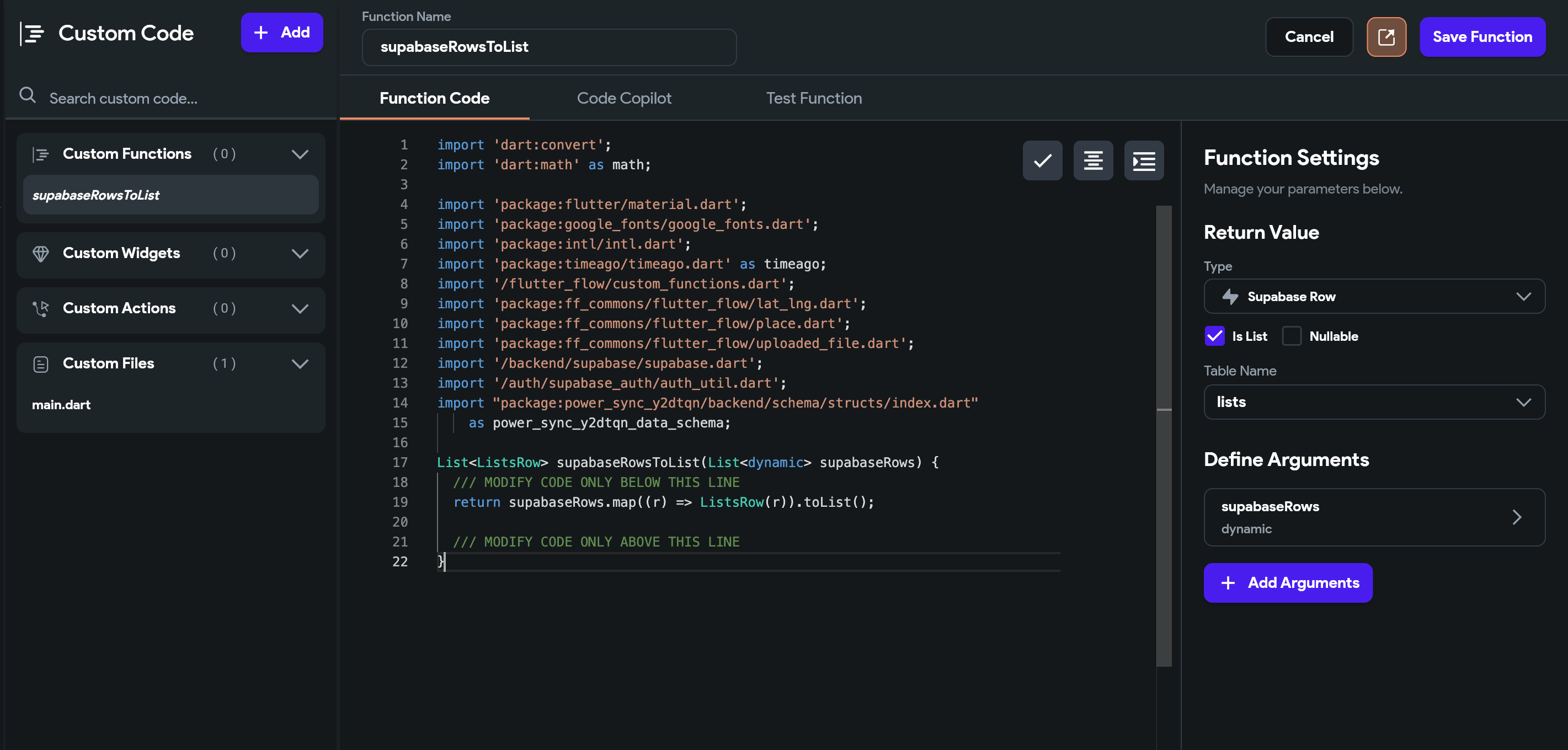
Custom function to map the lists table from Supabase
1. Auto-updating queries for Layout Elements with Dynamic Children
Create a Component to display List Items
- Under the “Page Selector”, click “Add Page, Component, or Flow”.
- Select the “New Component” tab.
-
Select “Create Blank” and call the component
ListItems. -
Under the “Widget Palette”, drag a “ListView” widget into the
ListItemscomponent. -
Still under the “Widget Palette”, drag a “ListTile” into the
ListViewwidget.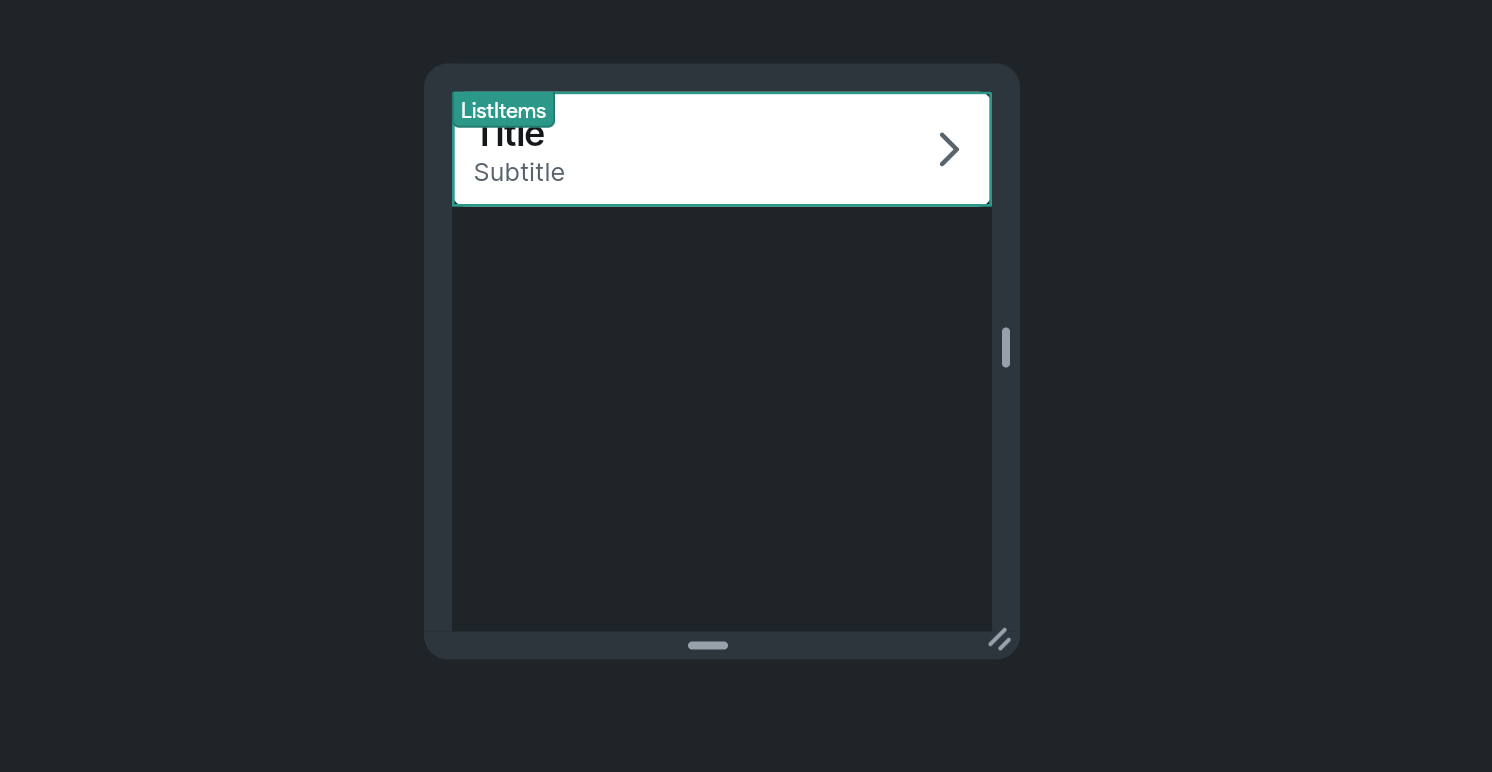
The ListItems component should now look like this
-
Under the “Widget Tree”, select the
ListItemscomponent.- At the top right under “Component Parameters” click “Add Parameters”.
- Click “Add Parameter”.
- Set its “Name” to
lists. - Set its “Type” to
Supabase Row. - Check “Is List”.
- Under “Table Name”, select
lists. - Click “Confirm”.
-
Still under the “Widget Tree”, select the “ListView” widget.
- Select the “Generate Dynamic Children” panel on the right.
- Set the “Variable Name” to
listItem. - Set the “Value” to the component parameter created in the previous step (
lists). - Click “Confirm”.
- Click “Save”.
- Click “Ok” when being prompted about the widget generating its children dynamically.
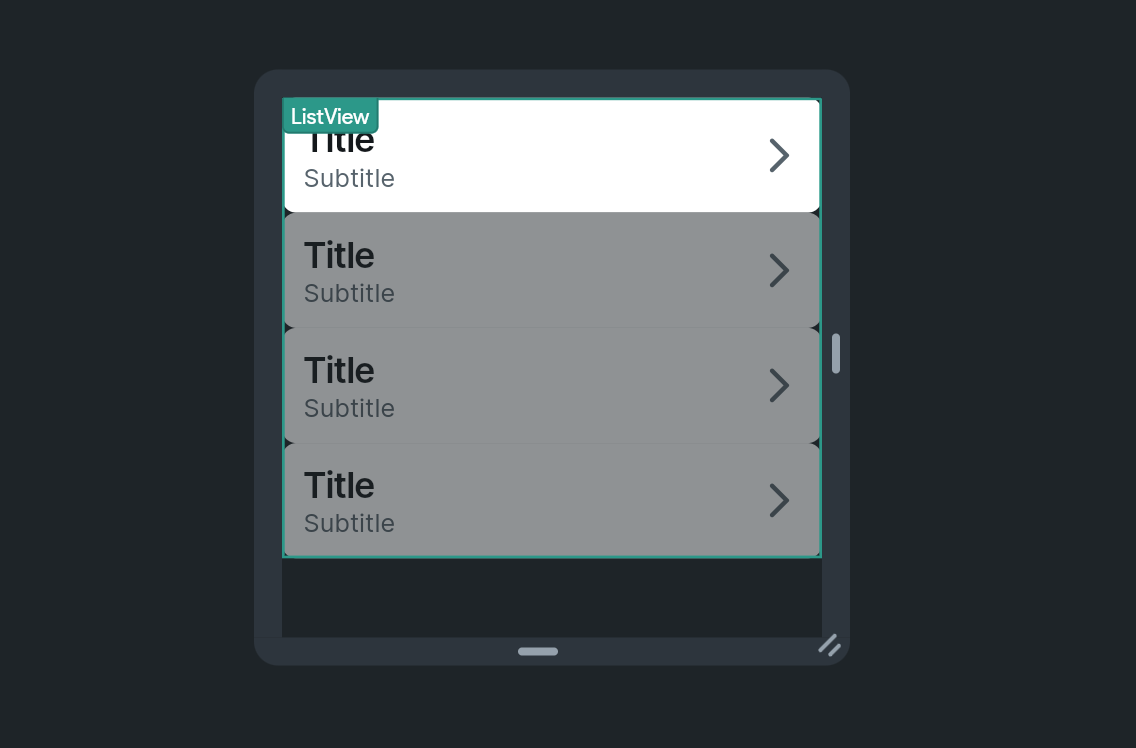
The ListItems component should now look like this
-
Still under the “Widget Tree”, select the
ListTilewidget.- In the “Properties” panel on the right, under “Title”, click on the settings icon next to “Text”.
- Set as “listItem Item”.
- Under “Available Options”, select “Get Row Field”.
- Under “Supabase Row Fields”, select “name”.
- Click “Confirm”.
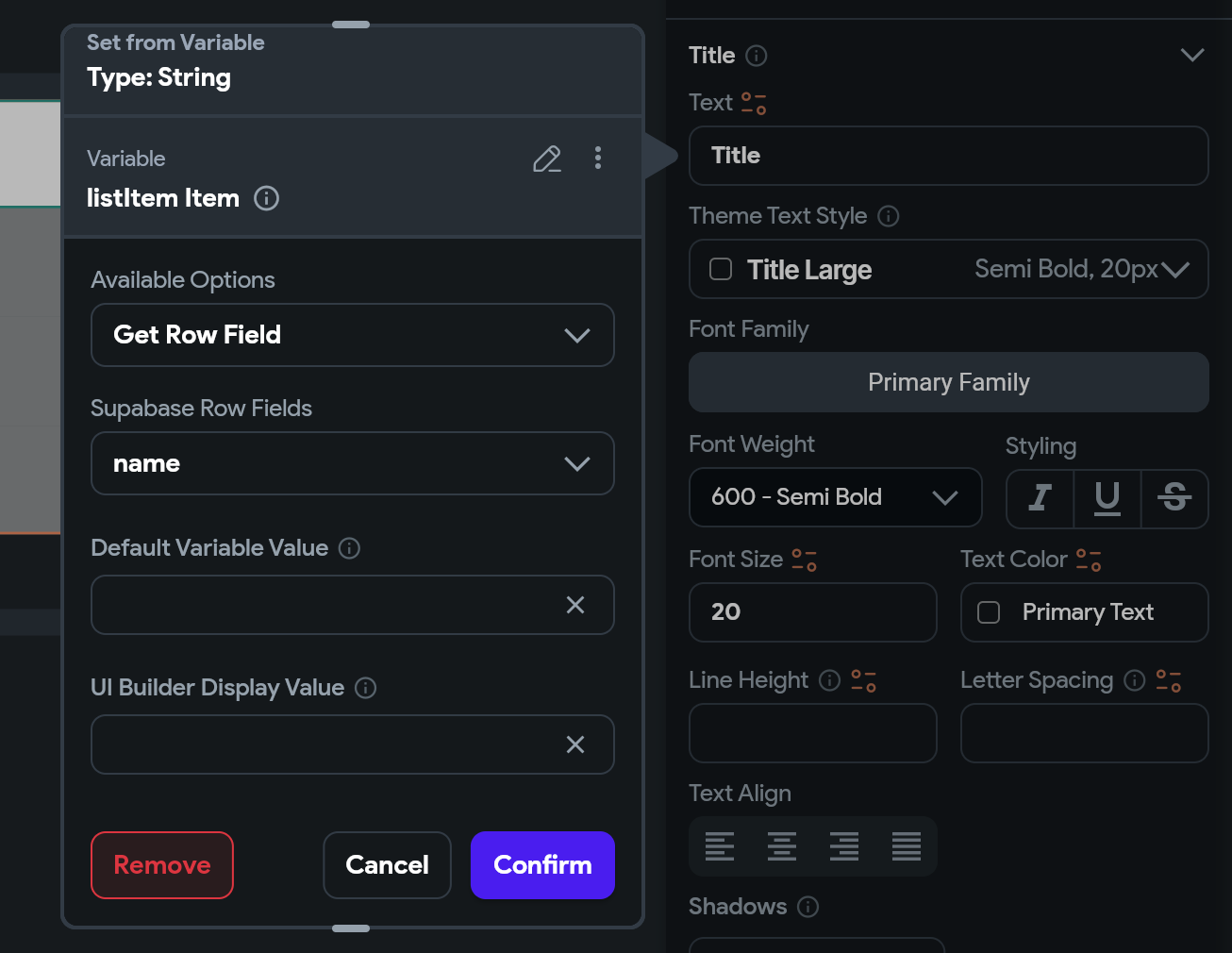
Set the list item title text
- Repeat Step 8 above for the “Subtitle”, setting it to “created_at”.
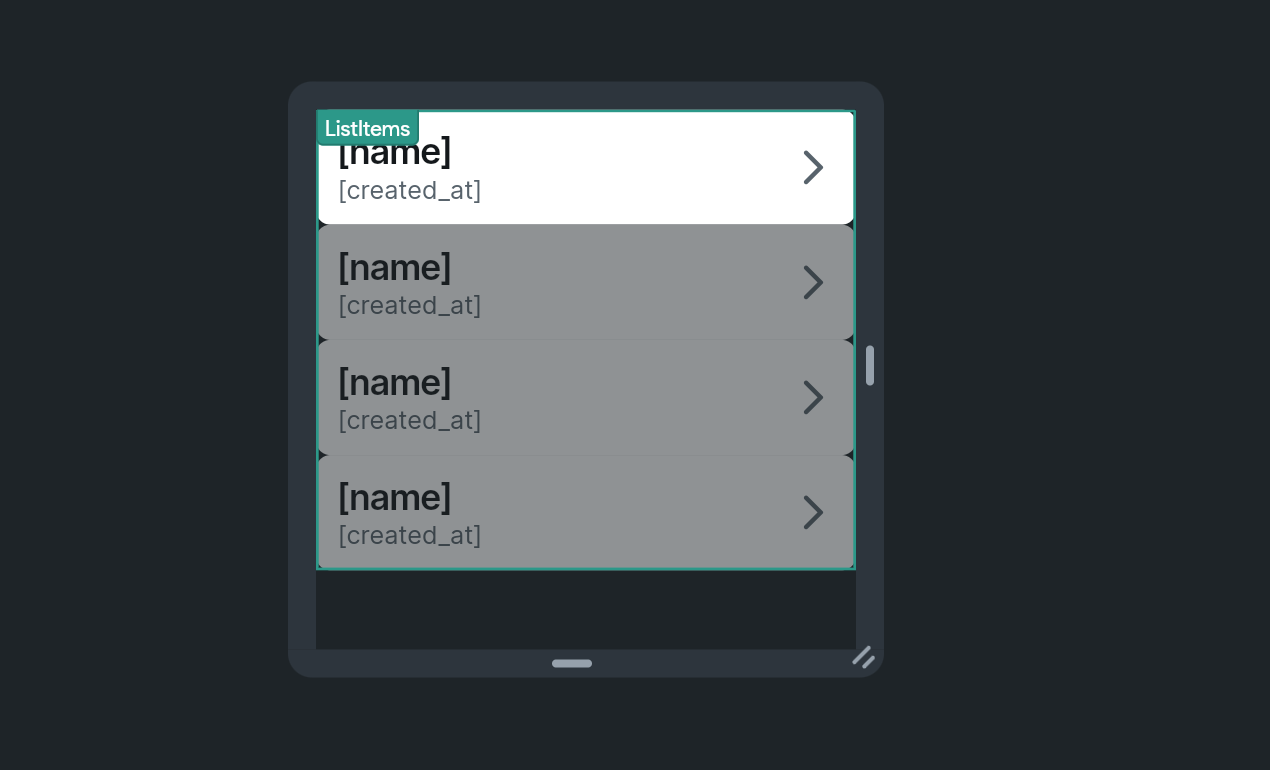
The ListItems component should now look like this
Display the List Component and populate it with Data
-
Under the “Page Selector”, select your
HomePage. -
Under the “Widget Palette”, select the “Components and custom widgets imported from library projects” panel.
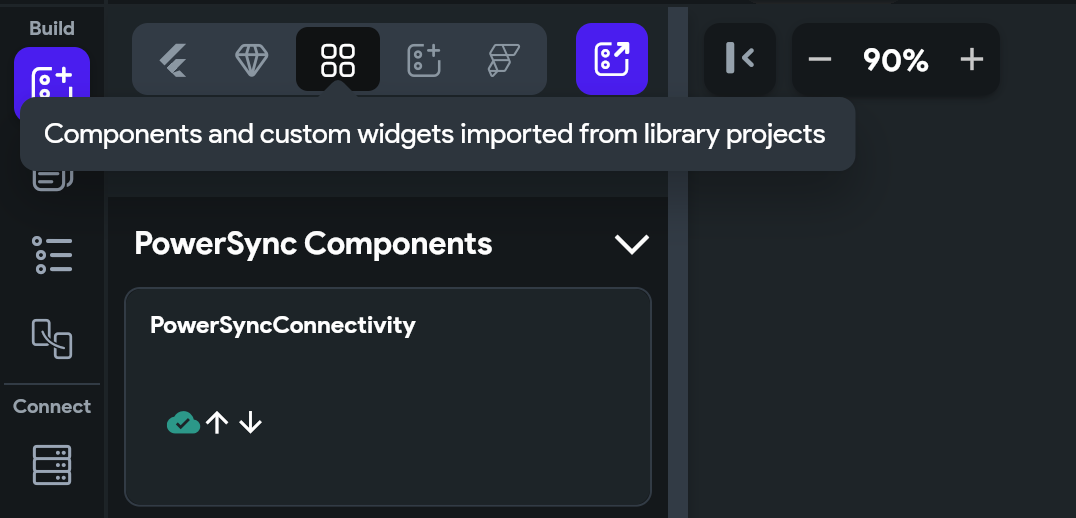
-
Drag the
PowerSyncQuerylibrary component into your page. -
In the Properties panel on the right, under “Component Parameters” -> “child”:
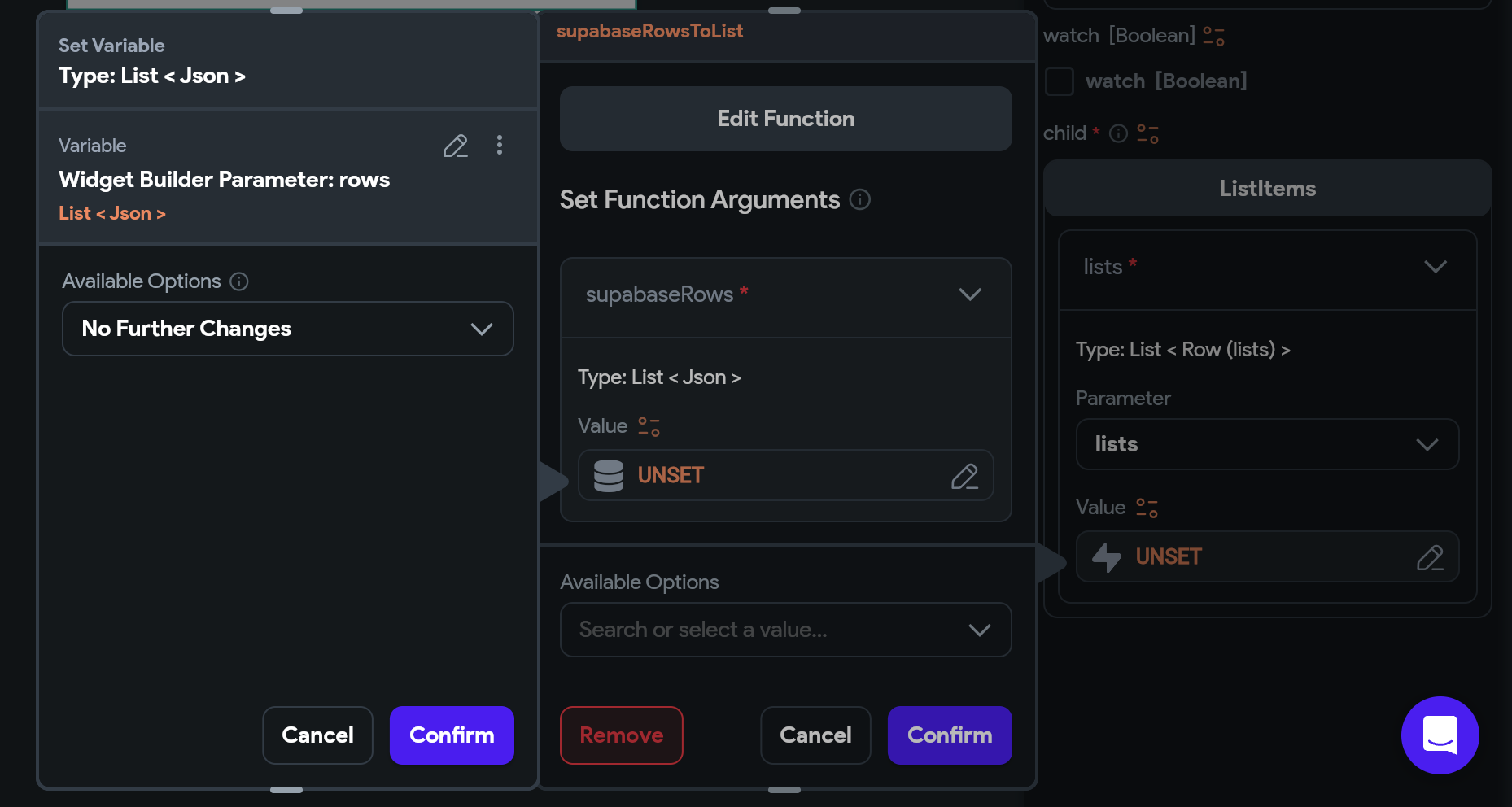
- Click on “Unknown”.
- Select
ListItemswe previously created. - Click on
lists. - Set the “Value” to “Custom Functions” ->
supabaseRowsToListwe created previously. - Under the
supabaseRowsargument, set the “Value” to “Widget Builder Parameters” ->rows. - Click “Confirm”.
- Click “Confirm”.
-
Still under “Component Parameters” add the SQL query to fetch all list items from the SQLite database:
- Paste the following into the “sql [String]” field:
select * from lists order by created_at; - For this query there are no parameters - this will be covered further down in the guide.
- Paste the following into the “sql [String]” field:
- Still under “Component Parameters”, check “watch [Boolean]”. This ensures that the query auto-updates.
Test your App
- Check that there are no project issues or errors.
- Reload your app or start another test session.
- Notice that your homepage is still blank. This is because the
liststable is empty in Supabase. Create a test row in the table by clicking on “Insert” -> “Insert Row” in your Supabase Table Editor.- Leave
idandcreated_atblank. - Enter a name such as “Test from Supabase”.
- Click “Select Record” for
owner_idand select your test user.
- Leave
Checkpoint: You should now see your single test row magically appear in your app: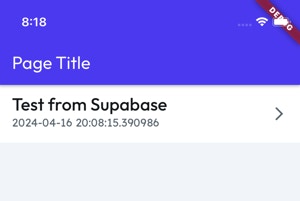

2. Auto-updating queries for basic Layout Elements
In this section, we will be making theListView component clickable and navigate the user to a page which will eventually display the list’s To-Do items. This page will show the selected list’s name in the title bar (“AppBar”). This uses Page State and the PowerSyncStateUpdater library component.
Create a Page Parameter
This parameter will store the selected list’s ID.- Under the “Page Selector”, click “Add Page, Component, or Flow”.

- Create a blank page and name it
Todos. - Under the “Widget Tree”, select your
Todospage. - At the top right of the “Properties” panel on the right, click on the plus icon for Page Parameters.
- Click “Add Parameter”.
- Set the “Parameter Name” to
id. - Set the “Type” to “String”.
- Click “Confirm”.
Create a Local Page State Variable
This variable will store the selected list row.- Still in the “Widget Tree” with the
Todospage selected: - Select the “State Management Panel” on the right.
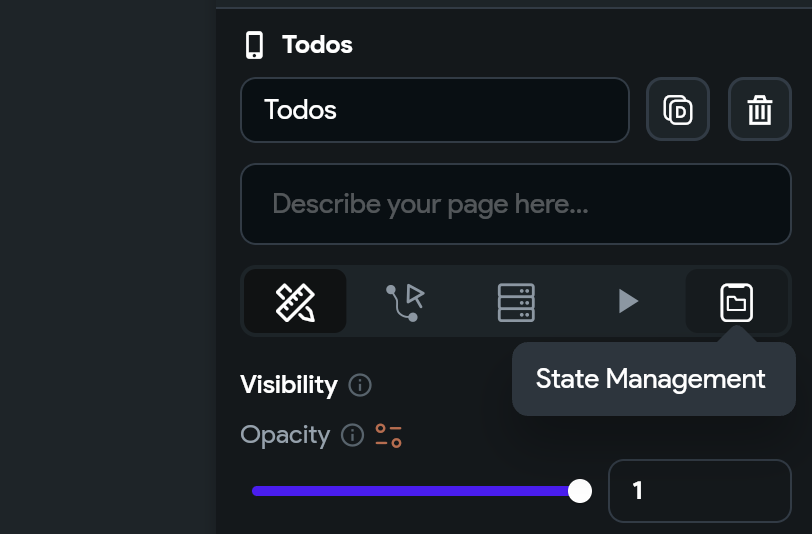
- Click on “Add Field”.
- Set “Field Name” to
list. - Set the “Type” to “Supabase Row”.
- Under “Table Name”, select
lists. - Click “Confirm”.
Bind the Page Title to the Page State
-
Under the “Widget Palette”, select the “Components and custom widgets imported from library projects” panel.

-
Drag the
PowerSyncStateUpdaterlibrary component into your page. -
Under the “Widget Tree”, select the
PowerSyncStateUpdatercomponent. -
In the “Properties” panel on the right, under “Component Parameters”:
- Add the SQL query to fetch the selected list from the SQLite database. Paste the following into the “sql [String]” field:
select * from lists where id = :id; - Click on “parameters [Json]” select “Create Map (JSON)” as the variable.
- Under “Add Map Entries”, click “Add Key Value Pair”.
- Set the “Key” to
id. - Set the “Value” to the page parameter created previously called
id. - Check “watch [Boolean]”. This ensures that the query auto-updates.
- Click “Confirm”.
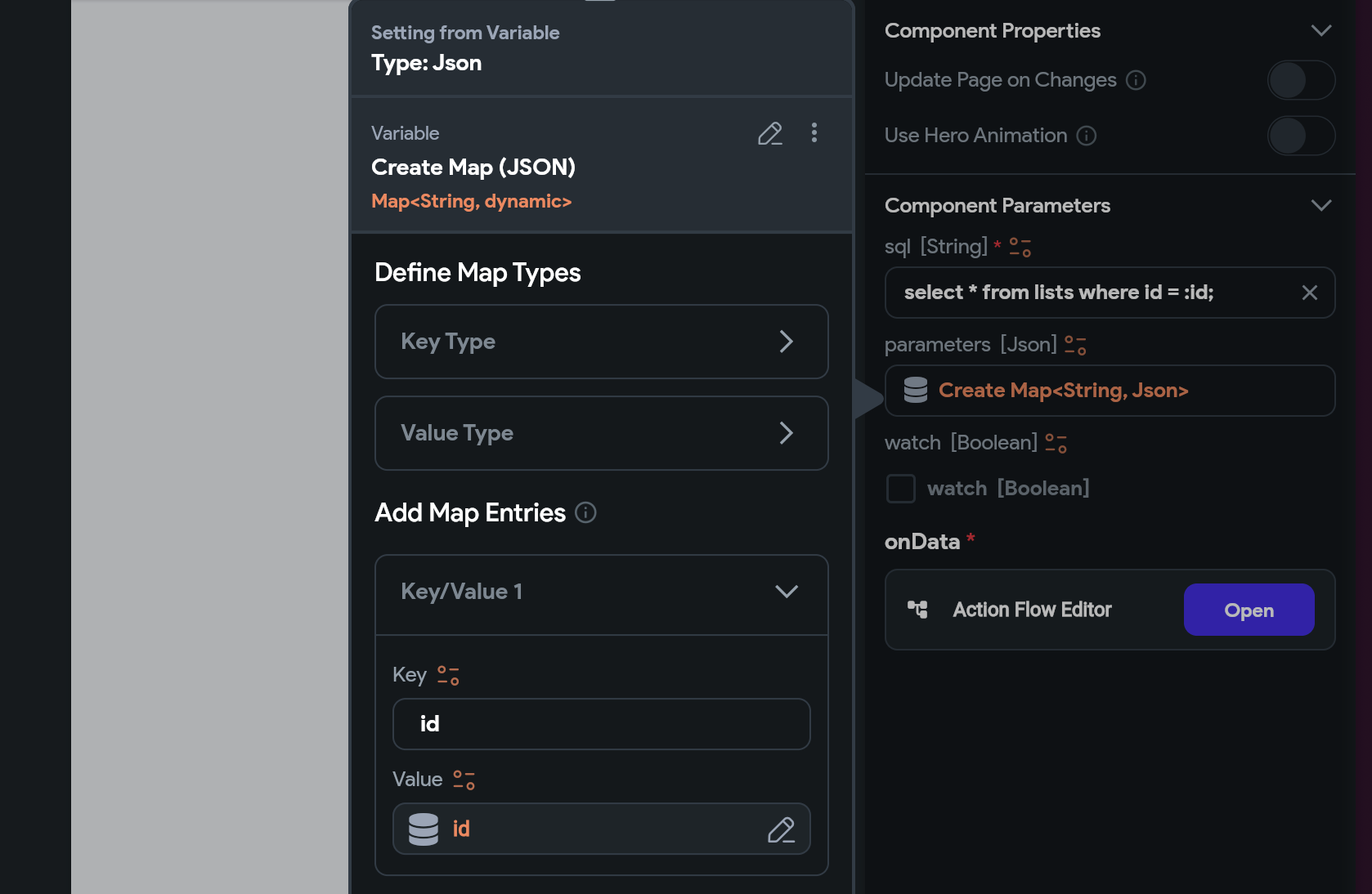
- Add the SQL query to fetch the selected list from the SQLite database. Paste the following into the “sql [String]” field:
-
Still under “Component Parameters”, configure the “onData” action:
- Open the “Action Flow Editor”.
- Select the “Callback” trigger type.
- Click “Add Action”.
- Search for “update page” and select “Update Page State”.
- Click “Add Field”.
- Select your
listpage state variable. - Set “Select Update Type” to “Set Value”.
- Set “Value to set” to “Custom Functions” ->
supabaseRowsToList. - Set the “Value” to “Callback Parameters” ->
rows - Click “Confirm”.
- Under “Available Options”, select “Item at Index”.
- Set “List Index Options” to “First”
- Click “Confirm”.
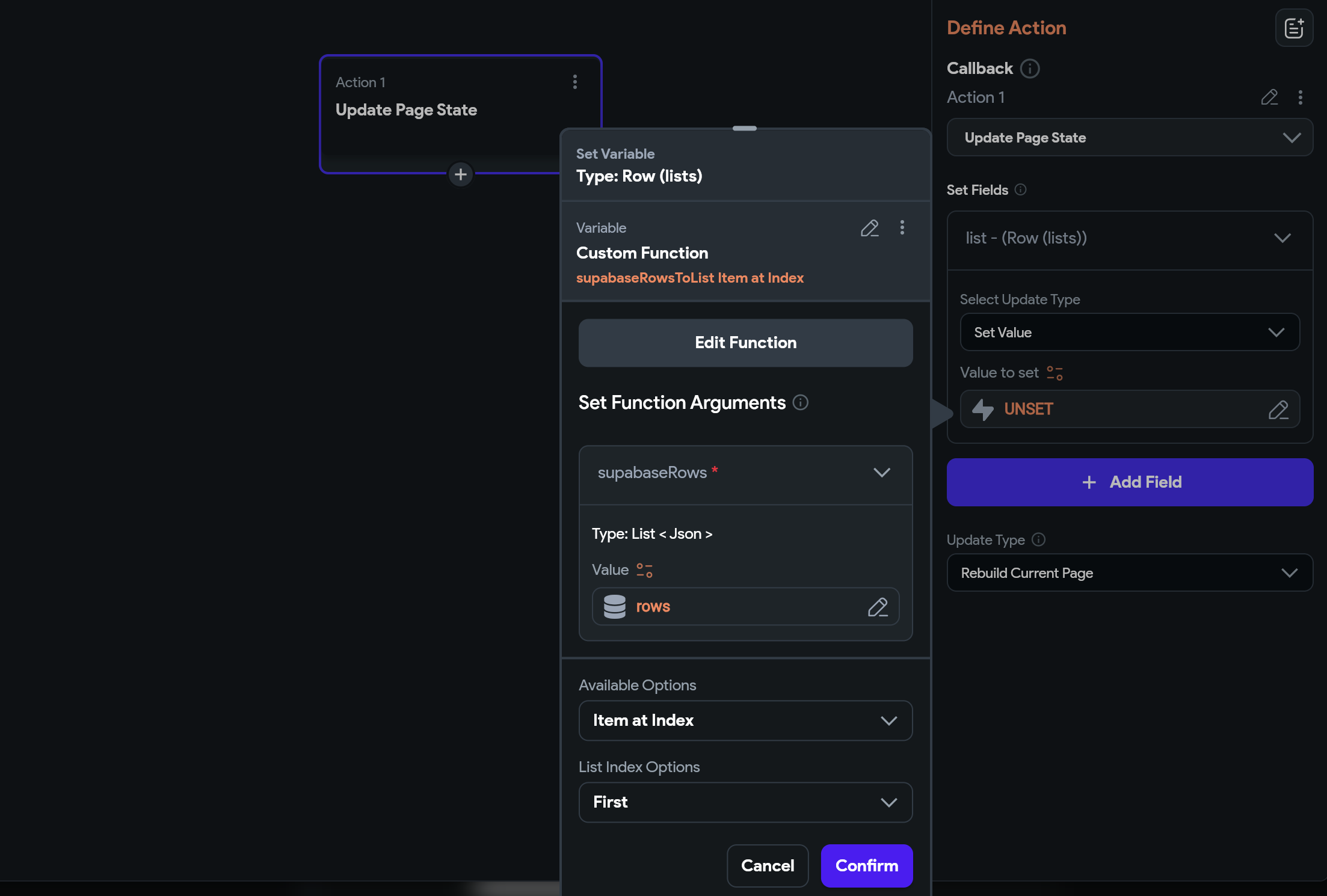
- Close the Action Flow Editor.
-
Still under the “Widget Tree”, select the “AppBar” -> “Text” widget.
- In the “Properties” panel on the right, click on settings icon next to “Text”.
- Click on “Page State” -> “List”.
- Set “Supabase Row Fields” to “name”.
- (Optional) Set the “Default Variable Value” to
List Name. - Click “Confirm”.
Make the ListView Component Clickable
- Under the “Page Selector”, select your
ListItemscomponent. - Under the “Widget Tree”, select the
ListTilewidget. - In the “Actions” panel on the right, click “Add Action”. “On Tap” should be selected by default.
- In the “Navigation” subsection, select “Navigate To”.
- Select the “Todos” page.
- Under “Parameters” click “Pass”.
- “id” should be auto-selected, click on it.
- Click on the settings icon next to “Value”
- Set it to “listItem Item”.
- Under “Available Options” select “Get Row Field”
- Under “Supabase Row Fields” select “id”.
- Click “Confirm”.
- (Optional) Enable the back button to navigate back:
- Under the “Page Selector”, select your
Todospage. - Under the “Widget Tree”, select the “AppBar” component.
- In the “Properties” panel on the right, enable “Show Default Button”.
- Under the “Page Selector”, select your
Test your App
Instant Reload your app or start another test session.Checkpoint: You should now be able to click on a list item and it should navigate you to a new page showing the name of the list in the title bar: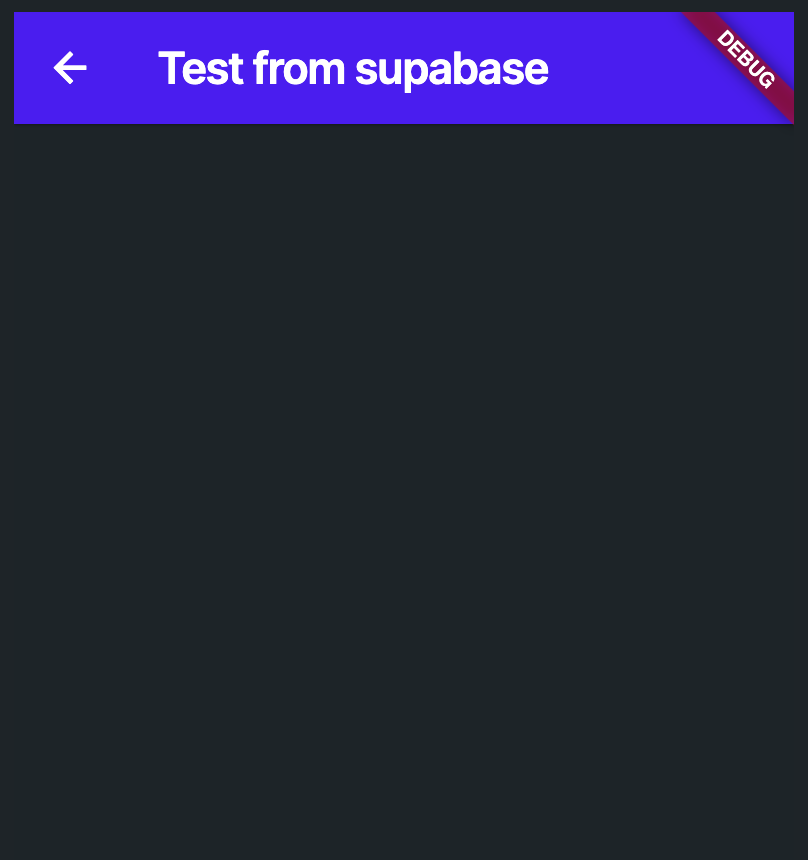

3. Once off reads for static data
This section is a work in progress. Please reach out on our Discord if you have any questions.
Create Data
You will now update the app so that we can capture new list entries.- Under the “Page Selector”, select your
HomePagepage. - Under the “Widget Palette”, search for “float” and drag the “FAB” widget onto your page.
- In the “Actions” panel on the right, click “Add Action”.
- Under “Custom Action” -> “PowerSync”, select “powersyncWrite”.
- Under the “Set Action Arguments” -> “sql” section, add the SQL query to create a new list item. For the purpose of this guide we are hardcoding the list’s name, normally you would build UI for this.
- Paste the following into the “Value” field:
INSERT INTO lists(id, created_at, name, owner_id) VALUES(uuid(), datetime(), 'new item', :userId);
- Paste the following into the “Value” field:
- Under the “parameters” section, set the
userIdparameter we’re using the above query:- Click on “UNSET”.
- Select “Create Map (JSON)” as the variable.
- Under “Add Map Entries”, click “Add Key Value Pair”.
- Set the “Key” to
userId. - Set the “Value” to “Authenticated User” -> “User ID”.
- Click “Confirm”.
Checkpoint: Reload your app and click on the + floating action button. A new list item should appear, which also automatically syncs to Supabase: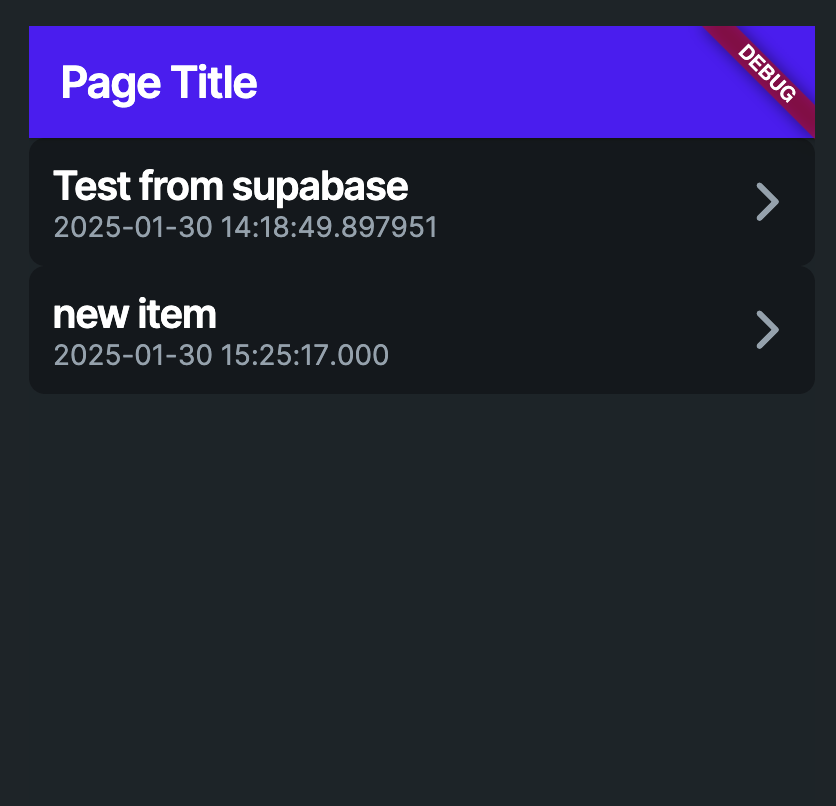

Update Data
Updating data is possible today using the
powersyncWrite helper of the Library, and a guide will be published soon. In the mean time, use the section below about Deleting Data as a reference. Please reach out on our Discord if you have any questions.Delete Data
In this section we will add the ability to swipe on aListTile to delete it.
-
Under the “Page Selector”, select your
ListItemscomponent. -
Under the “Widget Tree”, select the
ListTilewidget. - In the “Properties” panel on the right, enable “Slidable”.
- Click “Open Slidable”.
-
Select the “SlidableActionWidget”.
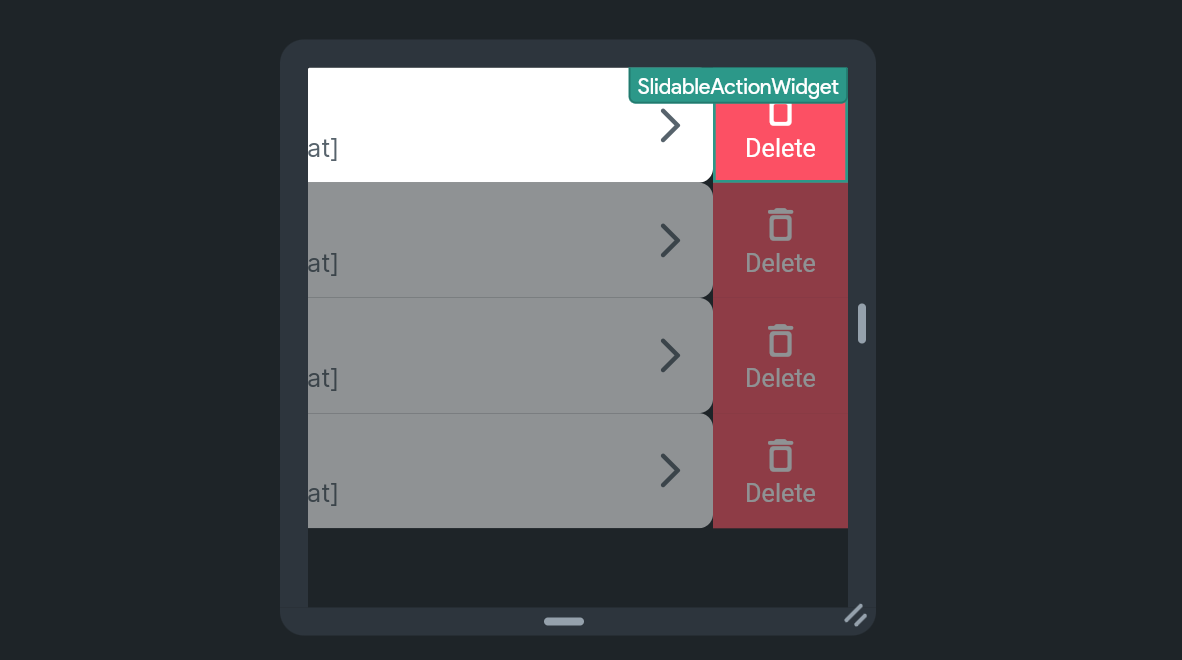
-
In the “Actions” panel on the right, click “Add Action”.
- Under “Custom Action” -> “PowerSync”, select “powersyncWrite”.
- Under the “Set Action Arguments” -> “sql” section, add the SQL query to delete the list item.
- Paste the following into the “Value” field:
delete from lists where id = :id;
- Paste the following into the “Value” field:
- Under the “parameters” section, set the
idparameter we’re using the above query:- Click on “UNSET”.
- Select “Create Map (JSON)” as the variable.
- Under “Add Map Entries”, click “Add Key Value Pair”.
- Set the “Key” to
id. - Set the “Value” to “listItem Item”.
- Under “Available Options” select “Get Row Field”.
- Under “Supabase Row Fields” select “id”.
- Click “Confirm”.
- Click “Confirm”.
Checkpoint: Reload your app and swipe on a list item. Delete it, and note how it is deleted from the list as well as from Supabase.
Sign Out
- Navigate to “Custom Code” and create a new Custom Action called
signOutwithout Arguments or Return Values and paste the below code:
In the below code,
power_sync_b0w5r9 is the project ID of the PowerSync library. Update it if it changes.- Click “Save Action”.
-
Under the “Page Selector”, select your
HomePagepage. -
Under the “Widget Palette”, drag a “Button” onto the right of your “AppBar”.
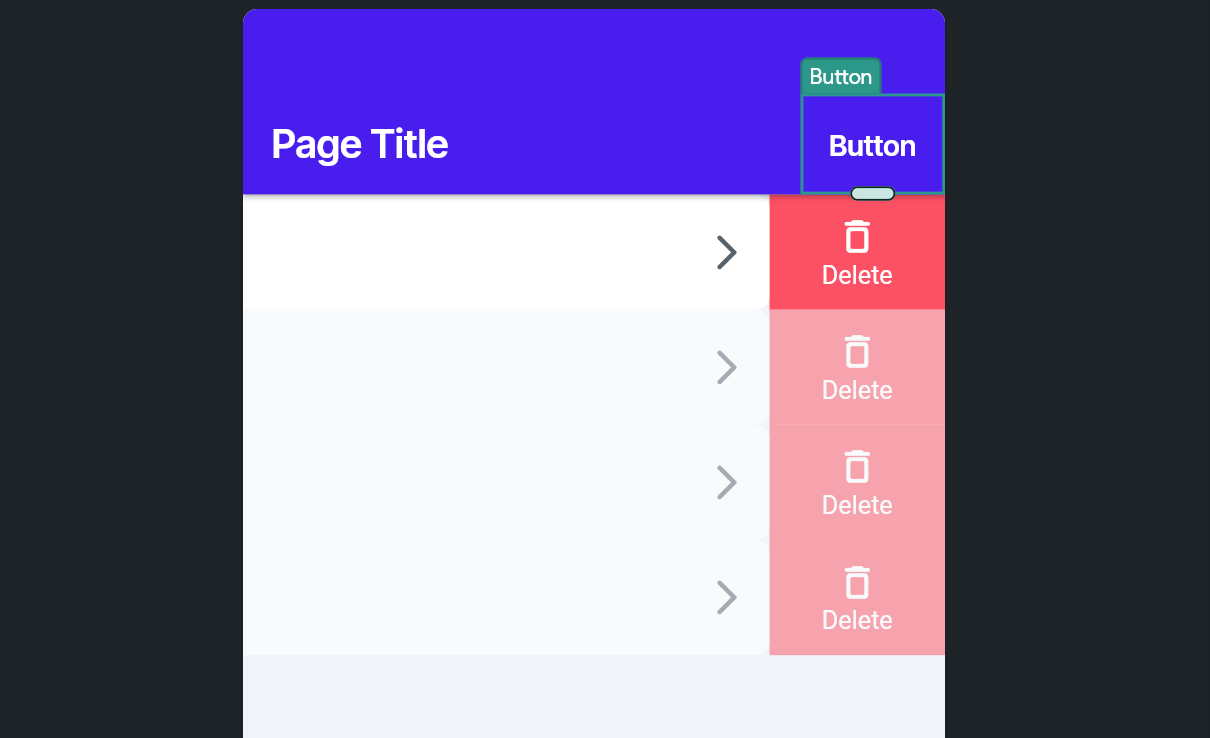
-
In the “Properties” panel on the right, rename the “Button Text” to
Sign Out. - Switch to the “Actions” panel and open the “Action Flow Editor”.
- Select “On Tap” as the action trigger.
-
Click “Add Action” and add a call to the
signOutCustom Action. - Chain another Action and call to “Supabase Authentication” -> “Log Out”:
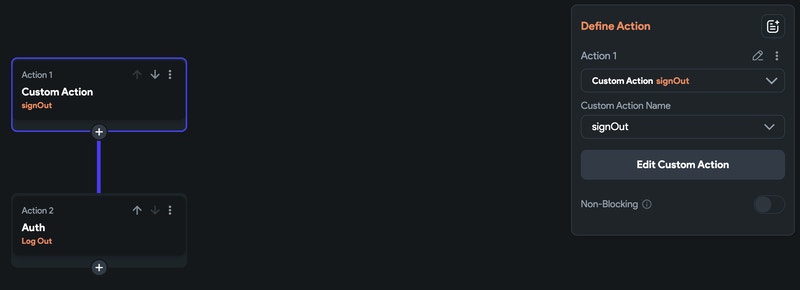
- Click “Close”.
Checkpoint: You should now be able to reload your app and sign out and in again.
(Optional) Display Connectivity and Sync Status
The PowerSync library provides a built-in component that displays real-time connectivity and synchronization status. Since the sync state is available globally as part of your app state, you can easily monitor the database status throughout your application. To add this status indicator:-
Under the Widget Palette, select the “Components and custom widgets imported from library projects” panel.

-
Drag the
PowerSyncConnectivitycomponent into your home page’s “AppBar”.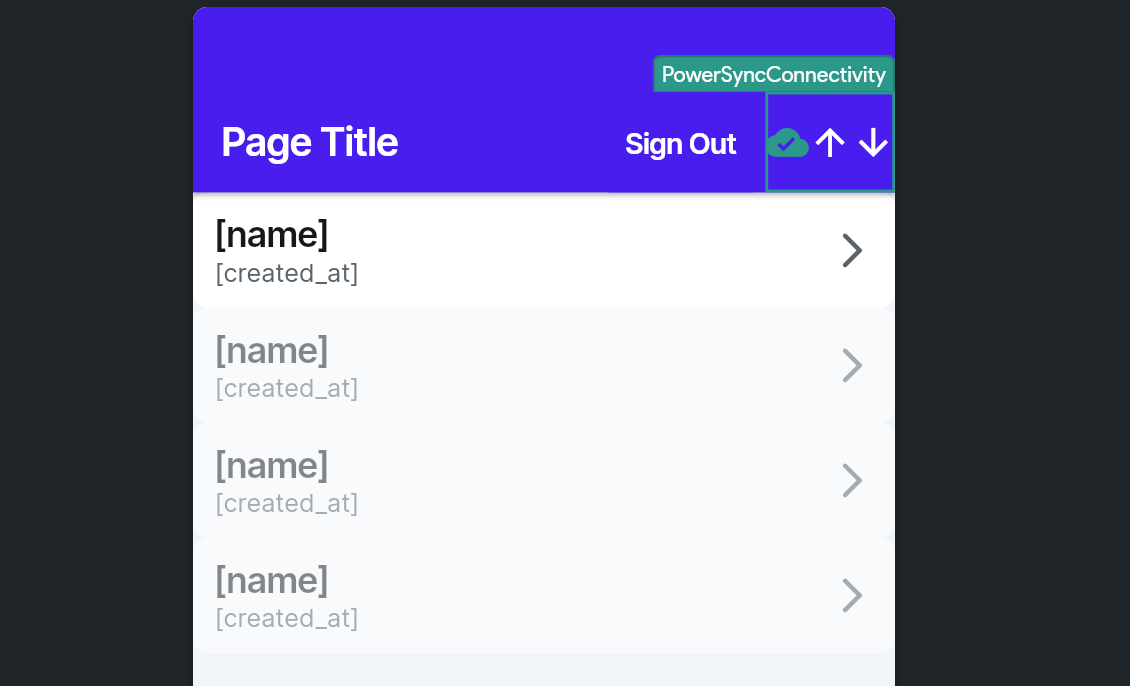
Secure Your App
PowerSync’s Sync Rules and Supabase’s support for Row Level Security (RLS) can be used in conjunction. Here are some high level similarities and differences:- RLS should be used as the authoritative set of security rules applied to your users’ CRUD operations that reach Postgres.
- Sync Rules are only applied for data that is to be downloaded to clients — they do not apply to uploaded data.
- Sync Rules can typically be considered to be complementary to RLS, and will generally mirror your RLS setup.
Enable RLS in Supabase
Run the below in your Supabase console to ensure that only list owners can perform actions on the lists table whereowner_id matches their user id:
Update Sync Rules
Currently all lists are synced to all users, regardless of who the owner of the list is. You will now update this so that only a user’s lists are synced to their device:- In the PowerSync Dashboard, select your project and instance and go to the Sync Rules view.
- Edit the Sync Rules in the editor and replace the contents with the below:
- Click “Validate”.
- Click “Deploy” to deploy your Sync Rules.
- Wait for the deploy to complete.
Checkpoint: Your app should continue running seamlessly as before.
Arrays, JSON and Other Types
For column values, PowerSync supports three basic types: Integers, doubles, and strings. These types have been chosen because they’re natively supported by SQLite while also being easy to transport as JSON. Of course, you may want to to store other values in your Postgres database as well. When syncing a value that doesn’t fit into the three fundamental types, PowerSync will encode it as a JSON string. To use those values in your app, you’ll need to apply a mapping so that you display the correct values and use the correct representation when uploading data. As an example, let’s consider an addedtags column on the lists table used in this guide. These tags will be
encoded as a string array in Postgres:
["default", "tags"].
FlutterFlow does not support extracting a list from that string, so the custom functions responsible
for mapping SQLite rows to FlutterFlow classes needs to be aware of the transformation and reverse it:
'["default", "tags"]' value as it appears into ["default", "tags"], the list value expected
for this row.
A similar approach is necessary when making local writes. The local database should be consistent with the
data synced with PowerSync. So all local writes should write array and JSON values as strings by
encoding them as JSON.
Finally, the PowerSync mapping also needs to be reverted when uploading rows to Postgres. For a
text[] column for instance, the local string value would not be accepted by Supabase.
For this reason, the upload behavior for columns with advanced types needs to be customized.
New feature: This option has been added in version
0.0.7 of the PowerSync FlutterFlow library.
Please make sure you’re using that version or later.applyPowerSyncOptions). After the
default imports, put this snippet:
main.dart as a final action.
When setting powersyncOptions.transformData, a callback is invoked every time a created or updated row
is uploaded to Supabase.
This allows you to customize how individual values are represented for Postgres. In this case, the tags
column of the lists table is decoded as JSON so that it’s uploaded as a proper array while being stored
as a list locally.
Custom Backend Connectors
To enable an easy setup, the PowerSync FlutterFlow library integrates with Supabase by default. This means that as long as you use Supabase for authentication in your app, PowerSync will automatically connect as soon as users log in, and can automatically upload local writes to a Supabase database. For apps that don’t use Supabase, you can disable this default behavior and instead rely on your own backend connectors. For this, create your own custom action (e.g.applyPowerSyncOptions). It’s important that this action runs
before anything else in your app uses PowerSync, so add this action to your main.dart as a final action.
Known Issues, Limitations and Gotchas
Below is a list of known issues and limitations.- Deploying to the Apple App Store currently requires some workarounds due to limitations in FlutterFlow:
- Download the code from FlutterFlow.
- Open the
Podfilelocated in theios/directory. - The following option in the
Podfileneeds to be updated fromuse_frameworks! :linkage => :statictouse_frameworks!(remove everything after the exclamation sign). - After removing that option, clean the build folder and build the project again.
- You should now be able to submit to the App Store.
- Exporting the code from FlutterFlow using the “Download Code” action in FlutterFlow requires the same workaround listed above.
- The PowerSync FlutterFlow Library does not currently support encryption at rest.
- Other common issues and troubleshooting techniques are documented here: Troubleshooting.